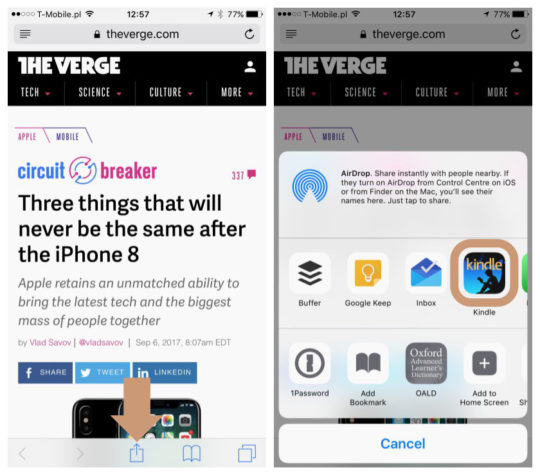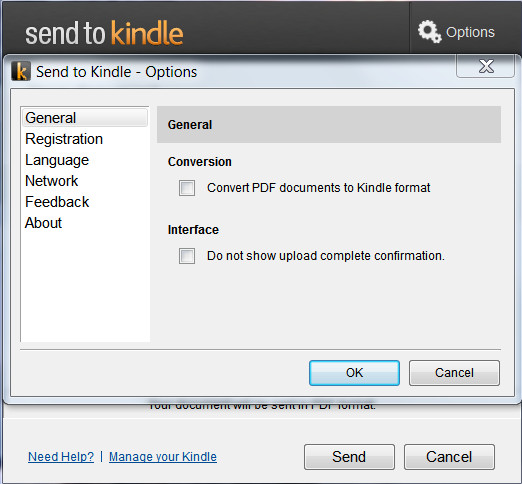

- #Send to kindle app size full#
- #Send to kindle app size software#
- #Send to kindle app size code#
- #Send to kindle app size professional#
It’s also the best formatter I’ve found currently available on the market. I’m personally more familiar with Kinstant and feel it’s so easy to use even an untrained novice can create professional-looking Kindle books. I highly recommend the Kinstant formatter or Scrivener. If you’ve followed Steps 1-4 carefully and don’t have much (if any) extra special formatting issues such as bullet points, images, tables, etc., you can use a converter tool to create your MOBI file, which is the file format recognized by Kindle devices and apps. Page numbers will probably appear as well, but these will disappear during the conversion process. Place your cursor at the beginning of the blank page you reserved for your TOC in Step 2 and insert it there. For example, if you wanted subheadings from Step 3 to appear in your TOC, be sure to choose settings that include subheadings (“Heading Style 2”) in the listing.

Using this built-in system, determine what you want your TOC to look like. Usually the TOC commands can be found under a “References” tab. Each version of Word is different, so I recommend you consult the “Help” menu for instructions. Microsoft Word has the built-in capability to link styles with Table of Contents listings. Step 4: Create your Table of Contents (TOC)

#Send to kindle app size code#
The more you customize your fonts, sizes, colors, etc., the more information gets translated into the code and can potentially be turned into junk code causing issues down the line. Keep in mind font types are limited on Kindle software, so it’s usually best practice to stick with the default font. This step can also be done during the writing process, and the default styles in Microsoft Word can be customized. The important thing is to set them apart so your reader knows you’re making a new point. If you don’t care if subheadings appear in the Table of Contents, you can just make them bold. Starting at the top of the document again, go through your entire book and apply the default “Heading 1” style to each section or chapter title (ie: Introduction, Foreword, Chapter 1… etc.) and the default “Heading 2” style to any subheadings throughout your book that you want to appear in the Table of Contents. While making your page breaks, remember to leave one blank page for your Table of Contents.
#Send to kindle app size professional#
Index (only when using a professional eBook programmer.Appendices including Bibliography, Glossary and Advertisements.Title page, including author’s name and publishing house (if applicable).Most eBooks consist of the following sections created with page breaks:
#Send to kindle app size software#
Step 2: Insert page breaksĪfter you’ve closely followed Step 1, start at the top of the document, place your cursor at the beginning of each section and chapter and hold down the “Ctrl” or “Cmnd” key on your keyboard and hit “Enter.” This will start each section on a new page and insert the proper code for the Kindle file letting the eBook software know that section is to begin on a new screen. You can customize some settings like first paragraph indents and spacing between paragraphs, but keep in mind every customization you make is a chance for more junk code to sneak into your Kindle file. Don’t justify your text, don’t hit “Enter” twice after a paragraph to insert extra space, never ever hit “Enter” over and over again to get your next chapter on a new page and don’t use tabs to begin paragraphs. Use the default settings in Microsoft Word. However if your eBook does not contain these formatting issues, here are 6 Easy Steps to turn your Microsoft Word document into a Kindle book: Step 1: Type it clean Getting rid of the junk code requires a solid knowledge in XHTML programming and bundling in EPUB and MOBI formats. doc file is turned into a bundle of XHTML files. All those issues insert extra code that translates into “junk” code when the.

If your Kindle book has bullet points, graphics, tables, block quotes or any other special formatting issues, this tutorial may not work for you. Some common formatting issues include wacky spacing, entire sections or chapters bolded and italicized, paragraphs split up, text flowing behind pictures and more.
#Send to kindle app size full#
There are hundreds of conversion programs and Kindle “meatgrinders” that promise clean Kindle files, yet deliver a file full of gobbledygook. This guest post is written by publishing authority and two time best-selling author Kristen Eckstein.Īnyone who’s tried formatting their eBook themselves will tell you it’s no small feat.


 0 kommentar(er)
0 kommentar(er)
